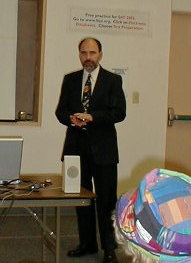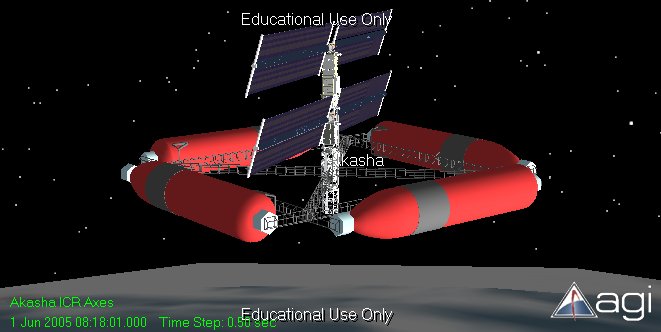






OASIS Lecture Series:
Going to Space on the Flying Trapeze
The CataMitt Recycler Concept Strives to Reduce the Price of Reaching Space
By Steve Bartlett
Recipe for cutting space access costs: combine one part cutting-edge structural materials with one part guidance technology from the “Star Wars” missile defense program. Add in a sprinkling of high-temperature superconductors and spin at high speed with ages-old flywheel technology. Pour into a framework in low Earth orbit and serve with lunar- and Mars-bound spacecraft.
 |
| Phil Turek during presentation. Photo by Steve Bartlett. |
This is the approach developed by physicist and educator Phil Turek for his CataMitt Recycler concept to dramatically lower space launch costs. Turek presented his ideas to an OASIS audience at the Long Beach Public Library on March 19.
The concept uses the idea of energy transfer between spacecraft moving between different orbits to send one vessel on its way to the Moon or Mars while slowing another that’s coming back from these destinations so that it can return safely to Earth. The craft leaving the vicinity of the Home Planet need extra energy to get where they’re going, while those returning need to lose their excess energy lest they burn up in the atmosphere. The CataMitt recycler serves as a large energy storage and transfer device, absorbing and storing the energy from spacecraft coming back to Earth and imparting it to spacecraft headed out. The idea is similar to impacting billiard balls, where a moving ball strikes a stationary one and imparts its momentum to the stationary one.
A spacecraft launched from Earth is captured by the orbiting recycler station using extremely strong cables made from carbon nanotubes. These tubes, which are currently under development at several research laboratories, are one hundred times stronger than steel. The station’s spinning flywheels deliver additional energy to the spacecraft so that it can head out beyond low Earth orbit. At the same time, incoming spacecraft from the Moon or Mars are captured by the recycler station and slowed down before they reach the Earth. Their excess energy is poured back into the flywheels. So the net loss of energy is nearly zero. This all requires careful timing and guidance to ensure that everything is where it needs to be when the transfer takes place, similar to two trapeze artists performing a pass in midair.
 |
| One configuration for the CataMitt Recycler. Image courtesy Phil Turek. |
Turek outlined his concept with charts and animated videos depicting how the spacecraft are captured and released, what the energy demands were, and how the technology for accomplishing this would be available within a few years. He backed up his ideas with examples of work being done in various fields which would make the approach viable. These examples included construction of carbon nanotubes samples for the tethers, high-temperature superconducting materials for storing and converting the energy, flywheels for storing and transferring large amounts of electrical energy, and spacecraft guidance technologies to put the spacecraft and the recycler station in the same place at the same time. He believes that this concept, if properly implemented, could substantially reduce the amount of propellants needed to reach orbit and leave for other parts of the Solar system. He has presented his ideas to NASA for consideration as a long-term technology which could greatly enhance our ability to explore and develop the solar system.
Currently a science teacher at Cerritos High School, Turek has mentored several award-winning student space colony design teams over the past fifteen years. (See cover story “City in Space, Student Designed”.) He is a finalist in the NASA Teacher in Space program to launch an educator aboard the Space Shuttle. He served as a crew member at the Mars Society’s Mars Desert Research Station in Utah in 2003. Prior to becoming a teacher, he worked for several years in the aerospace industry.
Copyright © 1998-2006 Organization for the Advancement of Space Industrialization and Settlement. All Rights Reserved.